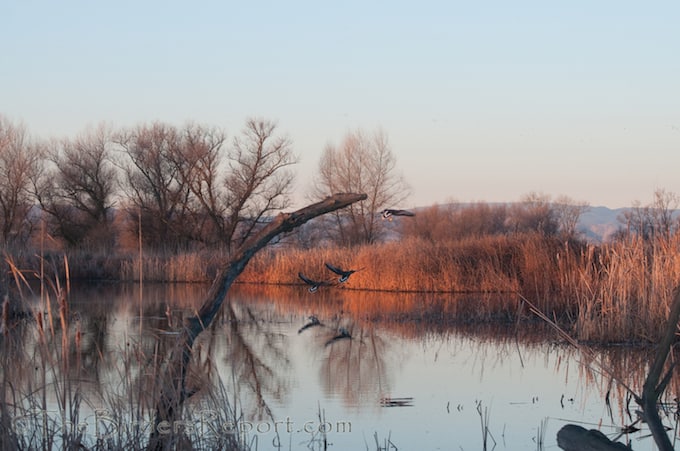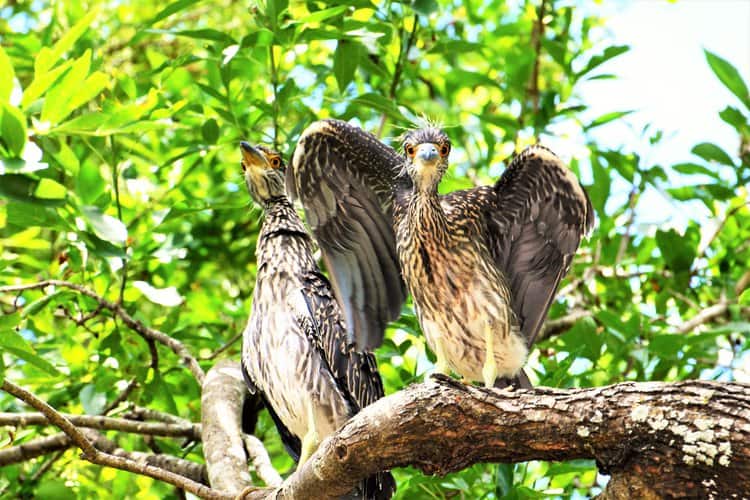Colusa National Wildlife Refuge is part of the Sacramento National Wildlife Refuge Complex located about 90 miles North of Sacramento, California’s state capitol. The Sacramento National Wildlife Complex consists of five national wildlife refuges (NWR) and three wildlife management areas (WMA) found in California’s central valley. Colusa NWR is located about 6 miles east of Interstate 5 on Highway 20. A map of the refuge can be found here showing the location of the viewing platform, auto loop, restrooms and photography blind. The photo above is a view from the photo blind.

Colusa National Wildlife Refuge occupies 4,567 acres, including seasonal marsh, permanent ponds, and uplands1. It includes a three mile auto loop, a one mile walking trail and a photography blind that you can reserve for a nominal fee.
When you arrive at the refuge, you will find two very new and clean restrooms and a large parking area. The one mile walking trail departs from just beyond that first parking lot and goes through a riparian area adjacent to the ponds where songbirds play and sometimes raptors perch.

When you come back from your riparian walk, just beyond where the trail began, you will se a large viewing platform overlooking a large wetalnd area. Here many ducks and other waterfowl can be seen up close.

This is where our wildlife can safely rest and build strength for the upcoming breeding season.

It is also where you might see a rare vagrant duck visiting from Asia. This Falcated Duck was first seen in December of 2011 and was seen again recently from the aforementioned viewing platform.

Once you tear yourself away from the viewing platform (and obviously, this may take some time) you can jump back into your vehicle and make your way around the three mile auto loop. You are certain to see raptors like this juvenile Red-tailed Hawk.

And near the back of the refuge under the trees in the shallow water on the right side, you may spot some Wood Ducks before the road makes a hard turn to the left. Power lines run along that back side of the refuge above an irrigation canal where you might not only spot raptors but a Belted Kingfisher as well.

Among the waterfowl always seen in the flooded marshes are the Bufflehead, Ruddy Duck, Mallard and Ring-necked Duck.

White-faced Ibis can often be seen in the shallow marshes as well. I got some very good looks at this one on the way back toward the parking lot…

and just before making the last turn for the final approach to the refuge entrance, on the South side of the road, you may spot hundreds of Ross’s Geese mixed in with the Snow Geese.

As ducks and geese leave for their breeding grounds, shorebirds arrive. Sandpipers, dowitchers, dunlin, avocets, black-necked stilts and others probe the mudflats for food. But, perhaps most fortunate of all, in that same section of the refuge, along the waterway, you can count on seeing a resident colony of Black-crowned Night-Herons to top off your visit!

Do you enjoy the National Wildlife Refuges in your area? National Wildlife Refuges have been underfunded since President Theodore Roosevelt created the first refuge in 1903 and Congress refused to appropriate money to manage it. Without adequate funding, habitats are not restored, invasive species are left unchecked, poaching and other illegal activities occur and our nation’s wildlife suffers1.
America’s National Wildlife Refuge System is the world’s largest network of protected areas dedicated to wildlife conservation. For more than a century, the refuge system has been integral to bringing species such as the whooping crane back from the brink of extinction. Each year, tens of millions of people visit and enjoy national wildlife refuges in every U.S. state and territory, infusing nearly $1.74 billion into local economies and creating more than 32,500 U.S. jobs2.
Would you like to be part of creating an additional income stream for our National Wildlife Refuge System? If you haven’t heard of our proposal for a Wildlife Conservation Stamp, please check out our new website where we will be promoting a plan to get an alternative stamp issued to increase revenue for our refuges.
We are looking for bird enthusiasts, photographers, bloggers, biologists, hikers, conservationists, wildlife rehabilitators, scientists, teachers, artists and anyone else with a common passion and concern for our nation’s wildlife and wild habitats to join us in encouraging our legislators to create an alternative to the Duck Stamp for non-consumptive users of the wildlife refuges.
If this sounds like a great idea to you, providing a consistent source of income for our refuges, separate but parallel to the current Federal Duck Stamp program, please send me an email with a short bio and a photo (at least 150 x 150 pixels) to place on our “About Us” page. We will keep you updated on our progress in this endeavor and entertain suggestions on the best way to implement our proposal.
I hope to hear from you soon! In the meantime, enjoy The Bird D’pot and Wild Bird Wednesday!
References: 1National Wildlife Refuge Association, 2Defenders of Wildlife
Larry Jordan
Larry Jordan is an avid birder and amateur photographer living on the Pacific Flyway near the Central Valley of Northern California. He is a board member of his local Audubon Society and is a bird and wildlife conservationist. Larry contributes to several wildlife conservation organizations and is a BirdLife International "Species Champion." He is also Habitat Manager for the Burrowing Owl Conservation Network, an organization dedicated to the protection and restoration of the Western Burrowing Owl population in the United States. Larry has been blogging about birds since September of 2007 at TheBirdersReport.com


Leave a Reply